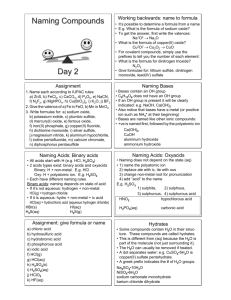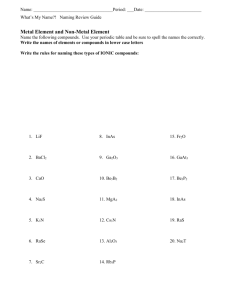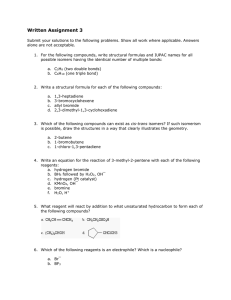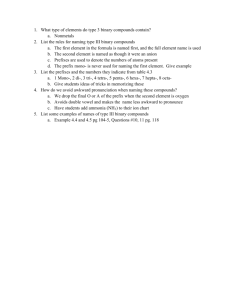Ionic Compounds
advertisement
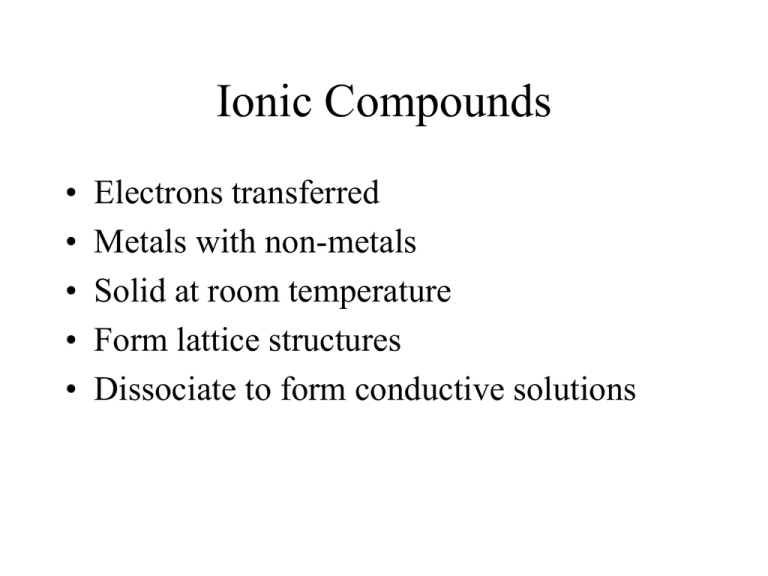
Ionic Compounds • • • • • Electrons transferred Metals with non-metals Solid at room temperature Form lattice structures Dissociate to form conductive solutions Rules for Naming Ionic Compounds 1.State the name of the metal –Ex. NaCl sodium 2. State the name of the non-metal or polyatomic ion -ex. NaCl sodium chloride * Do not capitalize Binary Compound (Metal/Nonmetal) with Fixed Charge Cation *Write the name of the following formula: H 2S • Look at first element and name it. Result of this step = hydrogen. • Look at second element. Use root of its full name ( which is sulf-) plus the ending "-ide." Result of this step = sulfide. Examples 1) MgS - magnesium sulfide 2) KBr - potassium bromide 3) Ba3N2 - barium nitride 4) Al2O3 - aluminum oxide 5) NaI - sodium iodide 6) SrF2 - strontium fluoride 7) Li2S - lithium sulfide 8) RaCl2 - radium chloride 9) CaO - calcium oxide 10) AlP - aluminum phosphide Binary Compound (Metal/Nonmetal) with Variable Charge Cation: Stock System *Write the formula from the following name: sodium bromide • Write down the symbol and charge of the first word. Result = Na+ • Write down the symbol and charge of the second word. Result = Br¯ • Use the minimum number of cations and anions needed to make the sum of all charges in the formula equal zero. In this case, only one Na+ and one Br¯ are required. • The resulting formula is NaBr. Examples • Write the correct formula for: 1) magnesium oxide - MgO 2) lithium bromide - LiBr 3) calcium nitride - Ca3N2 4) aluminum sulfide - Al2S3 5) potassium iodide - KI 6) strontium chloride - SrCl2 7) sodium sulfide - Na2S 8) radium bromide - RaBr2 9) magnesium sulfide - MgS 10) aluminum nitride - AlN Molecular Compounds • • • • Electrons shared Non-metals with non-metals Solid, liquid, or gas at room temperature Do not form conductive solutions Rules for Naming Molecular Compounds 1.State the name of the first non-metal using the correct greek prefix (except mono) -P2O5 _ diphosphorous 2. State the name of the second non-metal using the correct greek prefix - P2O5 diphosphorous pentoxide Greek Number Prefixes one two three four five monoditritetrapenta- six seven eight nine ten hexaheptaoctanonadeca- Examples Write the correct name for: 1) As4O10 tetrarsenic decoxide 2) BrO3 bromine trioxide 3) BN boron nitride 4) N2O3 dinitrogen trioxide 5) NI3 nitrogen triiodide 6) SF6 sulfur hexafluoride 7) XeF4 xenon tetrafluoride 8) PCl3 phosphorous trichloride 9) CO carbon monoxide 10) PCl5 phosphorous pentachloride Molecular Nomenclature Exceptions 1. hydrogen compounds -name like ionic compounds ex. HBr = hydrogen bromide 2. Organic compounds -special naming procedures – another unit! 3. Other -common names like water, molecular elements like Cl2 Acids • Hydrogen compounds in aqueous solutions • Form conductive solutions • Turns litmus red Rules for Naming Non-oxyacids 1. State hydro -ex. HCl(aq) hydro 2. State the name of the non-metal with “ic” on the end -ex HCl(aq) hydrochloric acid Rules for Naming Oxyacids 1. State the name of the polyatomic ion adding “ic” on the end or “ous” on the end If the polyatomic ion ends in “ate” add “ic” If the polyatomic ion ends in “ite” add “ous” -ex. H2SO4(aq) sulfuric acid -ex. H2SO3(aq) sulfurous acid
